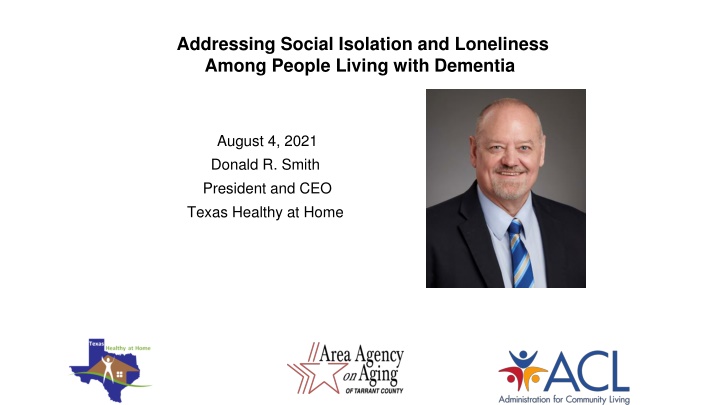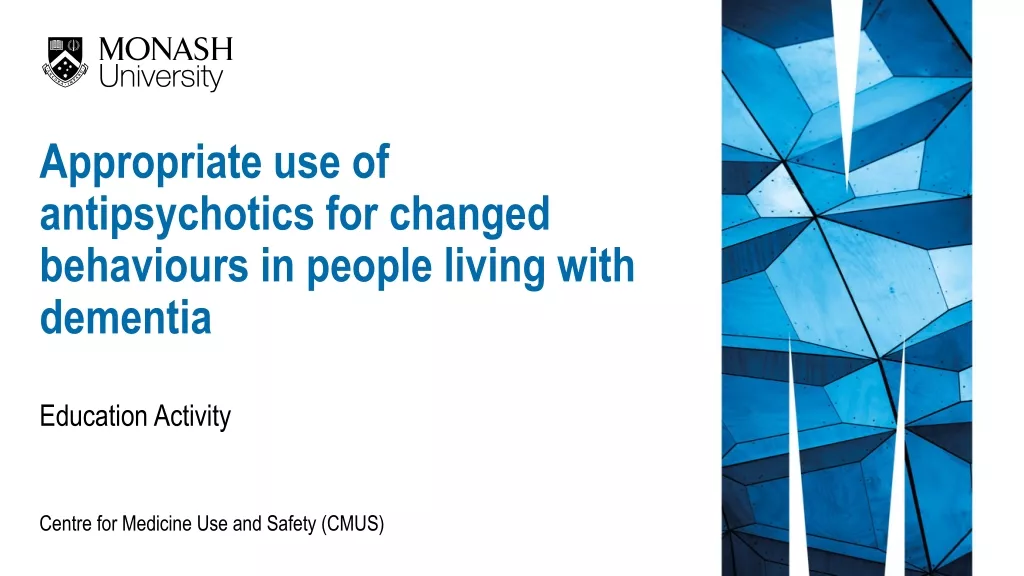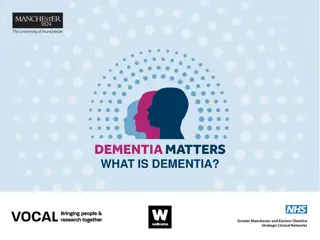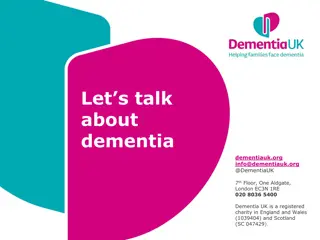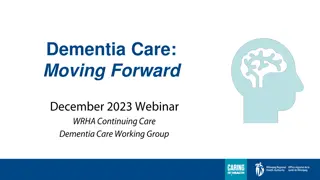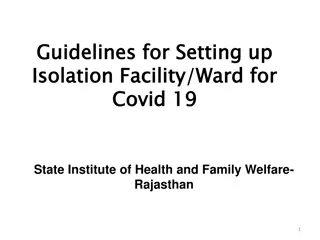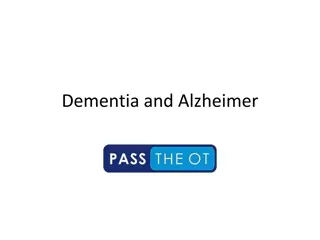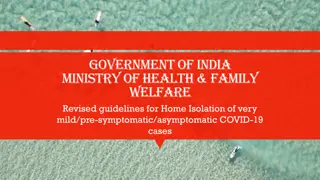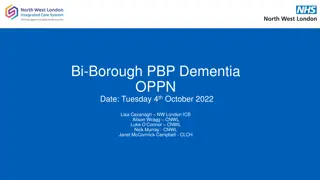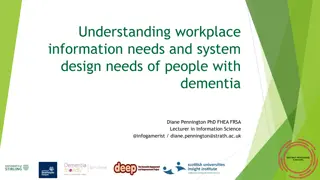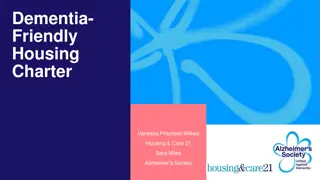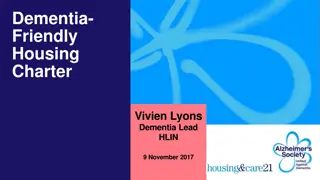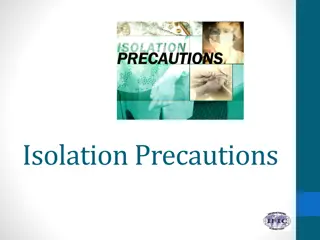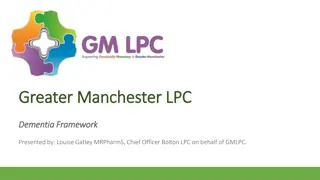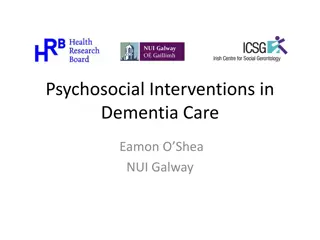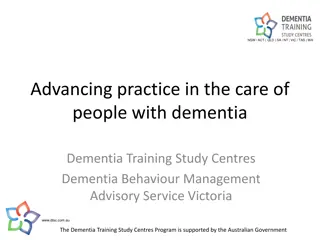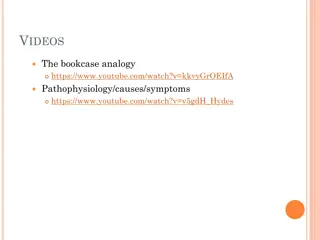Addressing Social Isolation Among People Living with Dementia
This article explores initiatives by Texas Healthy at Home to combat social isolation and loneliness among individuals with dementia in Tarrant County. It emphasizes the importance of community support and specialized services for those living alone with dementia, highlighting the impact of social relationships on overall health and well-being. Through targeted programming and collaboration with local organizations, Texas Healthy at Home aims to enhance the quality of life for vulnerable individuals while delaying nursing home placement and reducing healthcare costs.
Download Presentation

Please find below an Image/Link to download the presentation.
The content on the website is provided AS IS for your information and personal use only. It may not be sold, licensed, or shared on other websites without obtaining consent from the author.If you encounter any issues during the download, it is possible that the publisher has removed the file from their server.
You are allowed to download the files provided on this website for personal or commercial use, subject to the condition that they are used lawfully. All files are the property of their respective owners.
The content on the website is provided AS IS for your information and personal use only. It may not be sold, licensed, or shared on other websites without obtaining consent from the author.
E N D
Presentation Transcript
Addressing Social Isolation and Loneliness Among People Living with Dementia August 4, 2021 Donald R. Smith President and CEO Texas Healthy at Home
Overview Texas Healthy at Home (TH@H) Development of targeted programming in Tarrant County, TX Model for Alzheimer s/Dementia Services (MAS) Model for Alzheimer's/Dementia Focused on People Living Alone (MASPLA) Barriers and services for people living alone with Dementia Ongoing Related Initiatives
Texas Healthy at Home (TH@H) 501(C)3 nonprofit established 2015 Network of Texas Area Agencies on Aging + community- based organizations Maintains health and independence of vulnerable individuals; delays nursing home placement Integrates proven wellness programs/social services into healthcare settings Lowers healthcare costs for payers Helps network service providers generate new revenue, develop/expand services, maximize efficiencies
Tarrant County Demographics Total population: 2.1 million (3rdlargest Texas County) Over 60 population: 350,000+ Largest cities: Fort Worth (12th largest in US) and Arlington (49th) 13.3 % of Medicare Beneficiaries diagnosed with Alzheimer s Image result for att stadium
Alzheimers Disease Mortality Among Peer Counties, Texas and The United States, 2017
Social Isolation Increases Risk of Dementia Social isolation significantly increased a person s risk of premature death from all causes, a risk that may rival those of smoking, obesity, and physical inactivity. Social isolation was associated with about a 50% percent increased risk of dementia. Poor social relationships were associated with a 29% increased risk of heart disease and a 32% increased risk of stroke. Loneliness was associated with higher rates of depression, anxiety, and suicide. National Academies of Sciences, Engineering, and Medicine. 2020. Social Isolation and Loneliness in Older Adults: Opportunities for the Health Care System. Washington, DC: The National Academies Press. https://doi.org/10.17226/25663external iconexternal icon
Evolution of Dementia & Isolation Work in Tarrant County Neighbor Helping Neighbor (2006-2008) Community Living Program of Texas (2009-2011) Baylor Scott & White, Center for Applied Health Research, Temple, TX United Way Healthy Aging and Independent Living Initiative (2010 2019) https://www.tandfonline.com/doi/full/10.1080/10852352.2021.1930821
Evolution of Dementia & Isolation Work in Tarrant County (cont.) Resources for Enhancing Alzheimer s Caregiver Health (REACH TX) Nutrition, Fall Prevention, HomeMeds and Respite Focus on low to moderate cognitive impairment Over 90 % of high risk remain in community for over 6 months
The Economic Impact of Dementia Individuals Without Alzheimer's or other dementias Individuals With Alzheimer's or other dementias Medicaid Inpatient Hospital Nursing Home Skills Nursing Facility Hospice Home Health Care Medicare Medical Provider Prescription Medication $358 $3,509 $749 $462 $153 $367 $7,415 $3,569 $2947 $8,399 $10,862 $15,463 $6,750 $2,017 $2,525 $24,122 $5,792 $3,436 Average Annual Per-Person Payments for Health Care & Long-Term Care Services Provided to Medicare Beneficiaries Age 65 or Older, with and without Alzheimer s or Other Dementias in 2017 Dollars. Alzheimer's Facts and Figures 2018
Characteristics of Those Living Alone With Dementia 26% of those with dementia 50% do not have an identifiable caregiver 26% more hospital stays than those than living with a caregiver 29% more outpatient costs Alzheimer s Association: 2019 Alzheimer s Disease Facts and Figures
Carla, we dont have any people living alone with Dementia in Tarrant County, do we? May, 2016
Model for Alzheimers/Dementia Service (MAS) 2016-2019 Goal: Expand the existing dementia-capable system services and supports to increase access to culturally sensitive evidence-based support services to the unserved and underserved population with Alzheimer s Disease and Related Dementias (ADRD) and their caregivers (CGs).
MAS Results 327 people with ADRD, 385 caregivers received Dementia Specialized Support Services 161 clients received options counseling 87.4% persons living alone with ADRD connected to community resources 38.9% of caregivers served reported a reduction in caregiver burden (Zarit) Culturally and Linguistically Appropriate Services (CLAS) Standards Training Services for African American and Hispanic caregivers increased from 34.9% to 51.6% Services for African American and Hispanic people with ADRD increased from 36% to 58.4% The AD8: The Washington University Dementia Screening Test Adopted by all Partner Agencies
Tarrant Countys Future Healthcare Needs I m more concerned about dementia than anything else right now, said Don Smith, director of the United Way s Area Agency on Aging. We ve got people living alone with Alzheimer s and dementia right now. There s a need, Smith said, to integrate medical care with social services. Fort Worth Star Telegram, March 6, 2017, Bill Hanna: Report outlines Tarrant County s future healthcare needs. What are they?
Risks Of Living Alone With Dementia Sometimes we see things that are pretty glaring, Cook said. When I was a caseworker, a man invited me into the kitchen and had a paper plate on an electric stove and it was just starting to smoke. I reached over and put the plate in the sink. It was just starting to burn through the paper plate. In that instance, a call to the man s daughter took care of the issue David Andrews has banned his mom from the kitchen and disconnected the stove. As long as she can do the three T s - television, telephone and toilet - we re good, David Andrews said. But that could change tomorrow. Fort Worth Star Telegram, March 19, 2017, Bill Hanna: Dementia a difficult process for Haltom City woman and her son
MAS Focused on People Living Alone (MASPLA) Award Date: Expansion Grant awarded by ACL in March 2019 Identify: Using the in-home Dementia Screening Tool, AD8, for 1,200 People Living Alone with ADRD Goal: to prolong safe and independent living in the community for six additional months Serve: 855 clients will receive supportive services including Home Delivered Meals, Nutrition Counseling, HomeMeds, Respite, REACH II, In Home Banking & Money Management, or In-Home Physician Visits
MASPLA Results 3,282 people were screened and completed the AD-8 assessment tool 1,358 people were determined by AD-8 to have symptoms of Dementia 922 PLAADRD and their caregivers received Dementia Specialized Support Services: - 444 people received meals on wheels - 225 people received diabetes/nutritional counseling - 311 people received HomeMeds medication screening
MASPLA Results (cont.) 258 PLAADRD and their caregivers received options counseling 69.3% of person-centered goals were achieved among PLAADRD 70.9% of person-centered goals were achieved among the caregivers 68.1% of PLAADRD served showed statistically significant improvement in QOL-AD score 70.8% of caregivers served reported a reduction in Zarit caregiver burden score
AAA Dementia Options Counselor Focus Group What is the experience of a person living alone with dementia? Depression/ Anxiety/ Disturbed sleep Paranoia/ Mistrust/ Fear/ Confusion/ Hallucinations Financial difficulties and exploitation Family support conflicts and neglecting pet responsibilities No Transportation Difficulty remembering to eat and taking daily medications Multiple Chronic Conditions
Most Needed Services for People Living Alone with Dementia Assisted Transportation Personal Care/Attendant Services Nutrition/Dietitian HomeMeds/ Automatic Medication Aids Environmental Safety Medic Alert/Safe Return Visiting Physicians Money Management
Barriers to Serving People Living Alone with Dementia Lack of medical diagnosis barrier to access Public transportation Inflexibility of health care system Technology Lack of awareness about extent of problem Payers unaware of cost to taxpayers
Meals on Wheels of Tarrant County 2020 48% (1,893) with Dementia 26% (1,011) living alone with Dementia 30% (671) have formal diagnoses
Lessons Learned Working with Meals on Wheels (MOW) Experience serving target population Frequent contact with consumers Ability to monitor change in condition Can screen for Dementia Utilize functional assessment screens
Finding People Living Alone with Dementia Over half of referrals are from home health agencies and hospitals Texas Title IIIC2 Home Delivered Meal Assessment o Q 26: During the last 2 weeks, on how many days have you had trouble concentrating or making decisions? o Q 27: Does the consumer have the ability to make decisions independently? o Q 28: Does the consumer appear to have short-term memory impairment? Triggers AD-8 (Dementia Screening Test) for confirmation
Other Related Initiatives in Tarrant County Texas Takes on Dementia Workforce Education for Healthy Aging and Independent Living (GWEP) Dementia Friendly/ Age Friendly Fort Worth Dementia Friendly North Central/East Texas Health Resource Guide for Caregivers (Four Editions) $1.7 million Texas Health Hospital System Social Determinants/Isolation Projects
Texas Healthy at Home US Administration for Community Living: State Community Think Tank Baylor Scott & White (BSW) Partnership - Statewide virtual caregiver evidence-based programs (EBPs) - Statewide virtual dementia education by Alzheimer's Assn of Texas - REACH TX training by BSW Center for Applied Health Research University of North Texas Health Science Center Partnership - Expansion of EBPs to rural and underserved areas - Technical assistance and training to start EBPs
Donald R. Smith President and CEO Texas Healthy at Home d.smith@texashealthyathome.org
